The Corbett farm in Co Down is one in transition. Twenty-five-year-old Richard is now calling some of the shots, ably guided by his parents Edna and Nigel.
Cow numbers have increased from 87 in 2016 to 108 today, but the question is, should they increase further?
In 2016, the challenge was to grow and utilise more grass and, to be fair, the Corbetts have risen to this challenge. Average grass growth in 2019 was 11.4t DM/ha, while it was only 9.4t DM/ha in 2016.
Richard and Nigel are measuring grass most weeks and inputting the figures into Agrinet
This has been achieved through improving soil fertility, grass cultivars and access to certain paddocks. A new roadway was built at the end of 2017 which has improved access greatly.
Cows were out grazing by day until early November this year and they would have been out for longer if it wasn’t for the weather.
Richard and Nigel are measuring grass most weeks and inputting the figures into Agrinet, so they clearly see a benefit in measuring.
When the Irish Farmers Journal visited the farm this week, Richard was feeding really high-quality bale silage to the heifers and Nigel was able to tell me that this was produced from surplus grass during the summer.
In other years, that grass may have been eaten by the cows which would have depressed milk yield and protein percent.
No reseeding was done in 2019, but a few paddocks were reseeded in 2018 using varieties such as Abergain, Abermagic and Aston Energy. More reseeding is planned for 2020.
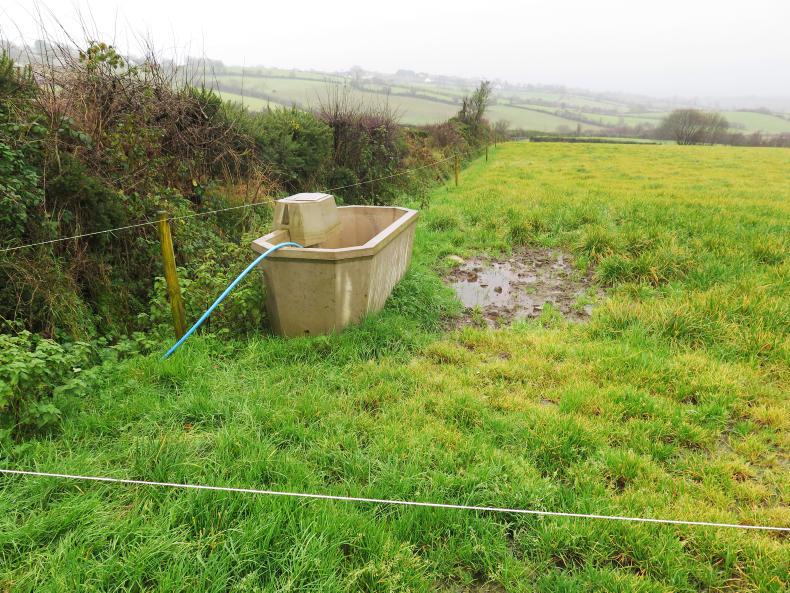
New water trough and reseeded field on the Corbett farm. This field has got very yellow from all the rain.
So the Corbetts are making better use of their main asset – their land. As a result, cow number have been able to increase and the farm remains self-sufficient in terms of winter feed.
However, 2018 did bring some challenges due to the late spring and drought.
Approximately £4,000 was spent on bought-in forage (round bale silage). After a good grass growing year in 2019, a silage reserve is now in place.
Another change on the farm has been the reduction of the sheep flock. The sheep are Edna’s responsibility and are mostly kept on an outfarm.
Ewe numbers have dropped to 30, meaning the 30 in-calf heifers were kept on the outfarm for the first time during the 2019 grazing season. This meant there was more grass available for the cows and calves on the home farm.
Current performance
About 65% of the cows calved in September and October this year, which is considerably more than in previous years.
Nigel is expecting 10 or 12 cows to calve in December, with less than 10 due after Christmas, but these will drag out for a few months.
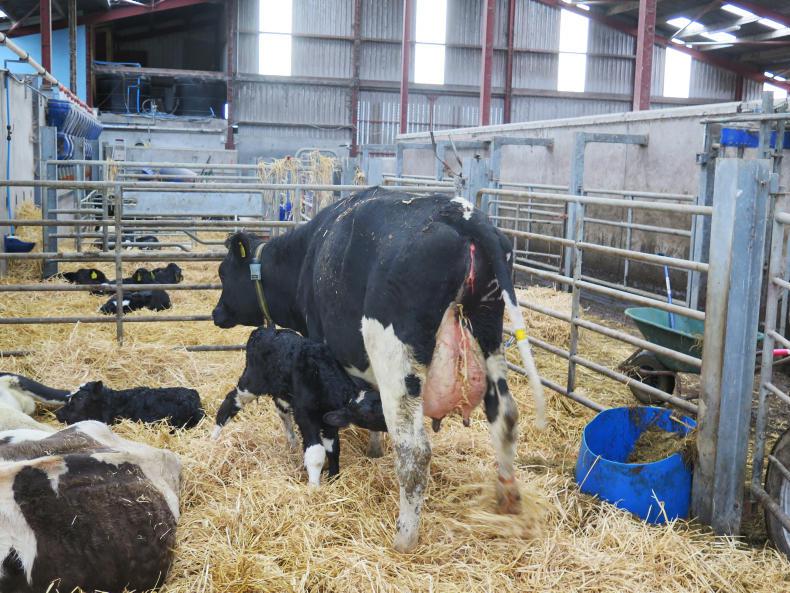
A freshly calved high-EBI cow on the Corbett farm.
Calving is going pretty well, with no real issues to report. Calves did get a short setback after going from whole milk to milk powder, but are back to normal now again and are looking very healthy.
They are being fed 800g of powder per day. Nigel was feeding over 1kg of powder per day when he went on powder first, but has since cut it back.
They were being fed 8l of whole milk prior to going on powder.
Cows are vaccinated for salmonella, BVD and IBR
Cubicle mattresses are cleaned down and bedded with a sawdust/hydrated lime mixture twice a day and Nigel says that, thankfully, mastitis hasn’t been an issue, excluding one case of E coli that rattled a first-calving heifer.
Cows are vaccinated for salmonella, BVD and IBR.
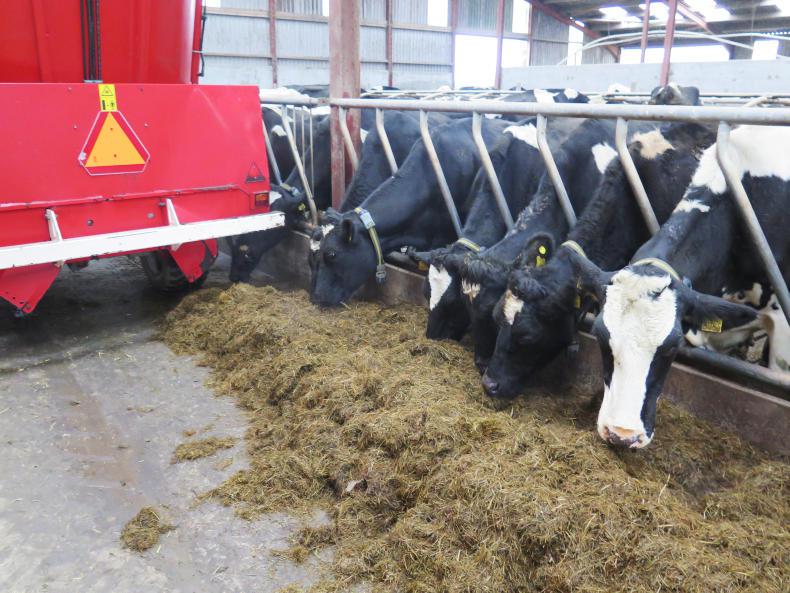
Cows being fed third-cut silage and 3kg of blend on the Corbett farm.
Sexed semen was used across most of the herd last season and, as a result, there are not many Holstein Friesian (HF) bull calves being born.
Instead, cows that they don’t want to breed from or are not suitable for sexed semen got a Belgian Blue straw.
These calves are selling for an average of about £260/head, while the few HF bull calves are making about £20/head at the mart.
We should have cows peaking at over 50l/day at the moment, but the peak is only around 46l/day
Cows are milking a bit less than Richard and Nigel would like, with the average yield currently around 23l/day. They would be targeting 27l or 28l/day for this time of year.
“We should have cows peaking at over 50l/day at the moment, but the peak is only around 46l/day.
“We got the silage analysed and it’s a bit low in energy, so we’ve increased the meal feeding rate to compensate. It’s third-cut silage. First-cut should be better, but the problem is we can’t access it until the third cut is eaten,” Nigel said.
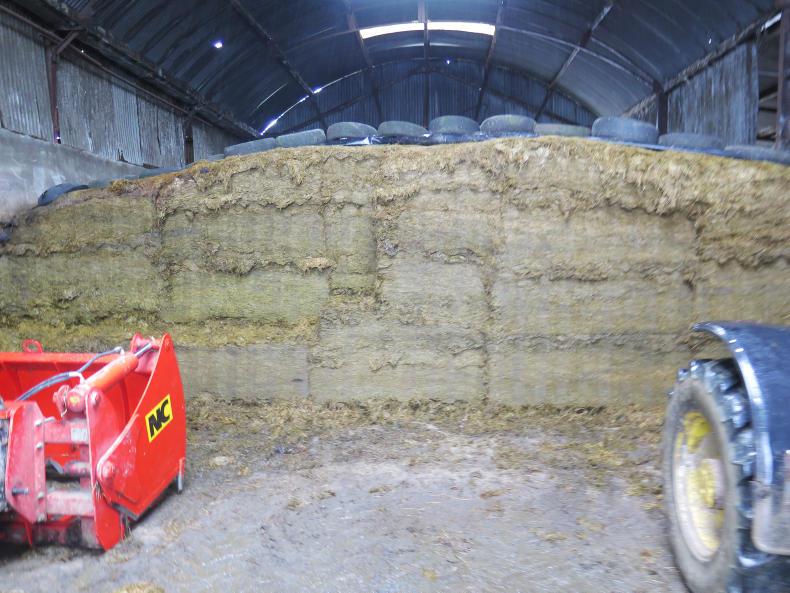
Third-cut silage is well preserved but hasn't tested well.
Up to this week, the milking cows were being fed blocks of silage every second day and fed to yield in the parlour. But because they’ve decided to up the meal feeding, they’re back using the diet feeder to mix the 3kg/cow of blend in with the silage.
Meal feeding in the parlour averaged 7.5kg/cow up to this week, but will be reduced now that the blend is being fed through the silage.
In the last season, the herd delivered 8,000l of milk per cow to Lakeland Dairies from a total of 2.4t of meal per cow. Nigel says his target is to produce this milk from around 1.8t of meal per cow.
Future plans
The Corbetts are farming a total of 68ha between owned and rented land, with 41ha around the yard. One option is to increase cow numbers by getting the heifers contract-reared.
Current stocking rate is 2.63 cows/ha on the milking platform and 2.2 LU/ha overall.
There are 145 cubicles on the farm, so contract-rearing the heifers and increasing cow numbers to 140 or 145 would mean that the overall stocking rate wouldn’t change drastically.
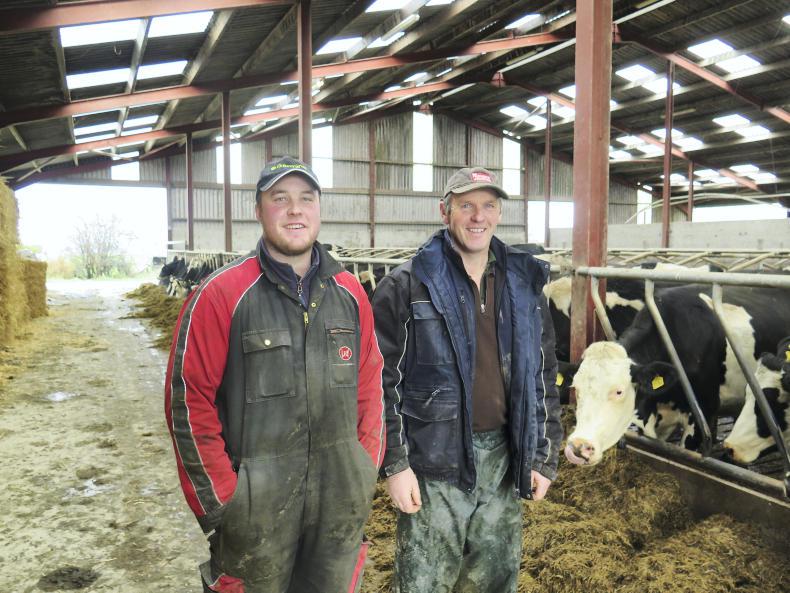
Richard and Nigel Corbett.
However, the stocking rate on the milking platform would increase to 3.5 cows/ha. Unless grass growth increases dramatically, the extra cows would all be fed from silage brought in from the out-blocks or meal purchased into the farm.
Most of the bulls used will be sexed semen
Both Richard and Nigel are adamant that they don’t want to fall into a confinement-type system.
Detailed plans will be drawn up over the coming months to determine the feasibility of this option.
Preparations are under way for the start of breeding on 12 December – a bit later than normal.
Most of the bulls used will be sexed semen, with a high profitable lifetime index (PLI).
Nigel has used a lot of high-EBI bulls over the last few years and is a bit disappointed with the yield of the first and second calvers.
Read more
Dairylink: driving milk from forage in Down
Dairy Day: top tips for hassle-free calf rearing
The Corbett farm in Co Down is one in transition. Twenty-five-year-old Richard is now calling some of the shots, ably guided by his parents Edna and Nigel.
Cow numbers have increased from 87 in 2016 to 108 today, but the question is, should they increase further?
In 2016, the challenge was to grow and utilise more grass and, to be fair, the Corbetts have risen to this challenge. Average grass growth in 2019 was 11.4t DM/ha, while it was only 9.4t DM/ha in 2016.
Richard and Nigel are measuring grass most weeks and inputting the figures into Agrinet
This has been achieved through improving soil fertility, grass cultivars and access to certain paddocks. A new roadway was built at the end of 2017 which has improved access greatly.
Cows were out grazing by day until early November this year and they would have been out for longer if it wasn’t for the weather.
Richard and Nigel are measuring grass most weeks and inputting the figures into Agrinet, so they clearly see a benefit in measuring.
When the Irish Farmers Journal visited the farm this week, Richard was feeding really high-quality bale silage to the heifers and Nigel was able to tell me that this was produced from surplus grass during the summer.
In other years, that grass may have been eaten by the cows which would have depressed milk yield and protein percent.
No reseeding was done in 2019, but a few paddocks were reseeded in 2018 using varieties such as Abergain, Abermagic and Aston Energy. More reseeding is planned for 2020.

New water trough and reseeded field on the Corbett farm. This field has got very yellow from all the rain.
So the Corbetts are making better use of their main asset – their land. As a result, cow number have been able to increase and the farm remains self-sufficient in terms of winter feed.
However, 2018 did bring some challenges due to the late spring and drought.
Approximately £4,000 was spent on bought-in forage (round bale silage). After a good grass growing year in 2019, a silage reserve is now in place.
Another change on the farm has been the reduction of the sheep flock. The sheep are Edna’s responsibility and are mostly kept on an outfarm.
Ewe numbers have dropped to 30, meaning the 30 in-calf heifers were kept on the outfarm for the first time during the 2019 grazing season. This meant there was more grass available for the cows and calves on the home farm.
Current performance
About 65% of the cows calved in September and October this year, which is considerably more than in previous years.
Nigel is expecting 10 or 12 cows to calve in December, with less than 10 due after Christmas, but these will drag out for a few months.

A freshly calved high-EBI cow on the Corbett farm.
Calving is going pretty well, with no real issues to report. Calves did get a short setback after going from whole milk to milk powder, but are back to normal now again and are looking very healthy.
They are being fed 800g of powder per day. Nigel was feeding over 1kg of powder per day when he went on powder first, but has since cut it back.
They were being fed 8l of whole milk prior to going on powder.
Cows are vaccinated for salmonella, BVD and IBR
Cubicle mattresses are cleaned down and bedded with a sawdust/hydrated lime mixture twice a day and Nigel says that, thankfully, mastitis hasn’t been an issue, excluding one case of E coli that rattled a first-calving heifer.
Cows are vaccinated for salmonella, BVD and IBR.

Cows being fed third-cut silage and 3kg of blend on the Corbett farm.
Sexed semen was used across most of the herd last season and, as a result, there are not many Holstein Friesian (HF) bull calves being born.
Instead, cows that they don’t want to breed from or are not suitable for sexed semen got a Belgian Blue straw.
These calves are selling for an average of about £260/head, while the few HF bull calves are making about £20/head at the mart.
We should have cows peaking at over 50l/day at the moment, but the peak is only around 46l/day
Cows are milking a bit less than Richard and Nigel would like, with the average yield currently around 23l/day. They would be targeting 27l or 28l/day for this time of year.
“We should have cows peaking at over 50l/day at the moment, but the peak is only around 46l/day.
“We got the silage analysed and it’s a bit low in energy, so we’ve increased the meal feeding rate to compensate. It’s third-cut silage. First-cut should be better, but the problem is we can’t access it until the third cut is eaten,” Nigel said.

Third-cut silage is well preserved but hasn't tested well.
Up to this week, the milking cows were being fed blocks of silage every second day and fed to yield in the parlour. But because they’ve decided to up the meal feeding, they’re back using the diet feeder to mix the 3kg/cow of blend in with the silage.
Meal feeding in the parlour averaged 7.5kg/cow up to this week, but will be reduced now that the blend is being fed through the silage.
In the last season, the herd delivered 8,000l of milk per cow to Lakeland Dairies from a total of 2.4t of meal per cow. Nigel says his target is to produce this milk from around 1.8t of meal per cow.
Future plans
The Corbetts are farming a total of 68ha between owned and rented land, with 41ha around the yard. One option is to increase cow numbers by getting the heifers contract-reared.
Current stocking rate is 2.63 cows/ha on the milking platform and 2.2 LU/ha overall.
There are 145 cubicles on the farm, so contract-rearing the heifers and increasing cow numbers to 140 or 145 would mean that the overall stocking rate wouldn’t change drastically.

Richard and Nigel Corbett.
However, the stocking rate on the milking platform would increase to 3.5 cows/ha. Unless grass growth increases dramatically, the extra cows would all be fed from silage brought in from the out-blocks or meal purchased into the farm.
Most of the bulls used will be sexed semen
Both Richard and Nigel are adamant that they don’t want to fall into a confinement-type system.
Detailed plans will be drawn up over the coming months to determine the feasibility of this option.
Preparations are under way for the start of breeding on 12 December – a bit later than normal.
Most of the bulls used will be sexed semen, with a high profitable lifetime index (PLI).
Nigel has used a lot of high-EBI bulls over the last few years and is a bit disappointed with the yield of the first and second calvers.
Read more
Dairylink: driving milk from forage in Down
Dairy Day: top tips for hassle-free calf rearing









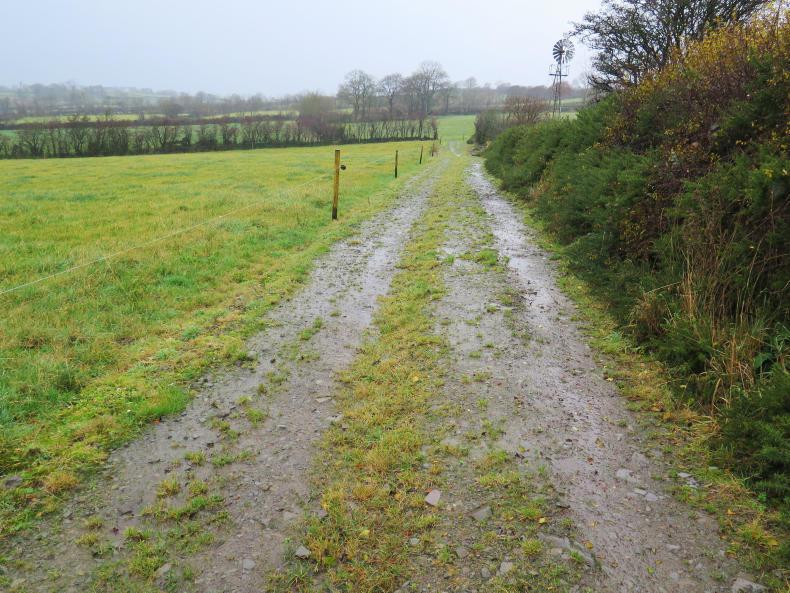
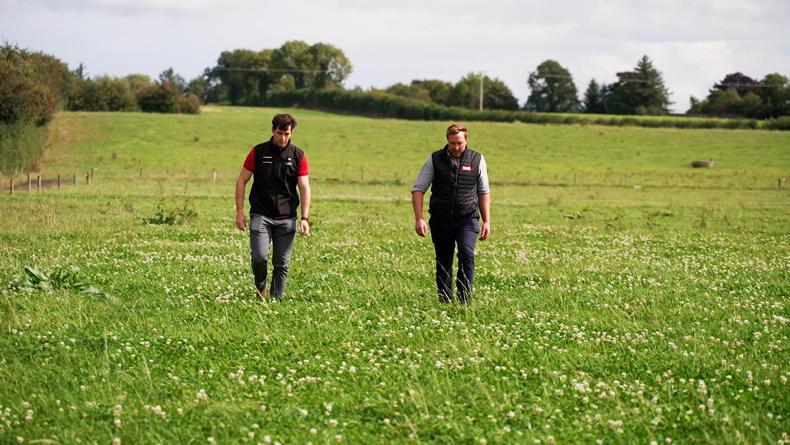
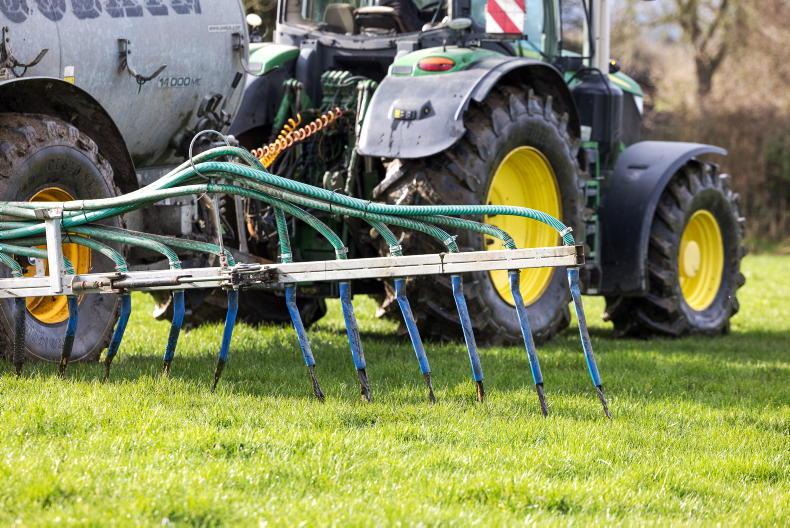


SHARING OPTIONS